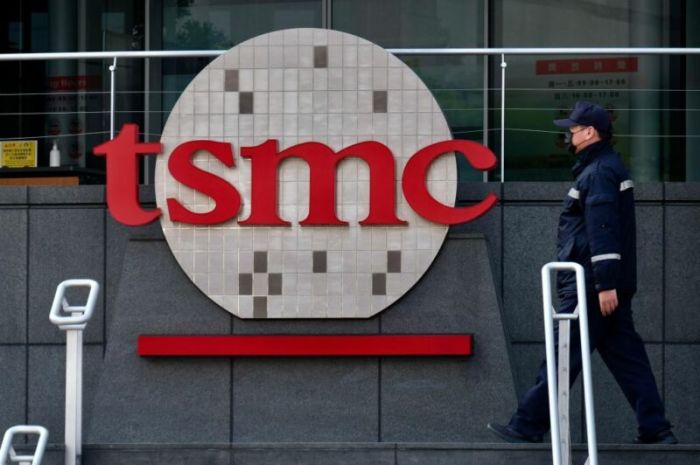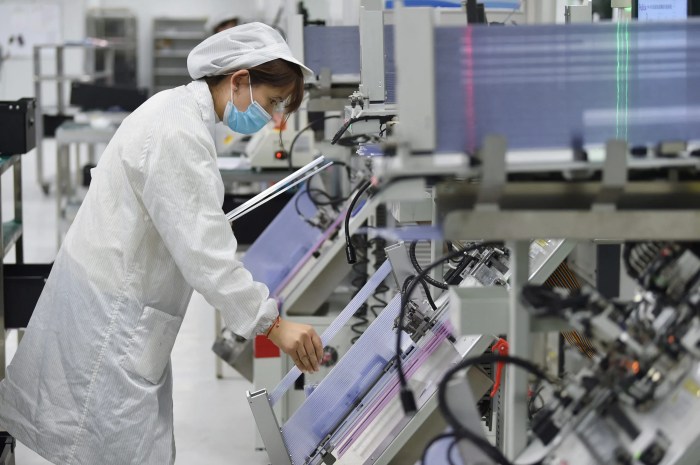The US is reportedly working on a list of restricted Chinese chipmaking factories, escalating the ongoing tech rivalry between the two nations. This potential move signals a significant escalation in the trade war, potentially impacting global supply chains and technological advancements. The move raises numerous questions about the future of the semiconductor industry, and the motivations behind the US’s actions are likely complex and multifaceted.
This potential restriction targets specific Chinese chipmaking facilities, potentially impacting various sectors within the Chinese chip industry. The repercussions could ripple through global markets, affecting everything from consumer electronics to critical infrastructure. This detailed analysis explores the potential consequences, motivations, and alternative scenarios surrounding this significant development.
Background and Context

The US-China rivalry in the semiconductor industry is intensifying, fueled by geopolitical concerns and the desire to maintain technological dominance. This dynamic has led to a complex web of trade restrictions and sanctions, impacting global supply chains and innovation. Reports of the US preparing a list of restricted Chinese chipmaking factories highlight the escalating nature of this competition, raising concerns about the future of the semiconductor industry and its global implications.The escalating tensions between the US and China have been a driving force behind the growing trade restrictions and sanctions imposed on Chinese technology companies.
The US has imposed export controls on certain technologies, aiming to curb China’s advancement in specific sectors, including advanced semiconductor manufacturing. These restrictions are intended to mitigate the perceived threat to US national security interests.
Potential Motivations Behind the Restrictions
The US government’s potential move to restrict Chinese chipmaking factories is likely driven by a combination of factors. These include concerns about the potential for Chinese companies to acquire sensitive technology, potentially diverting it to military applications or use for surveillance. The US also seeks to maintain its technological edge in the semiconductor industry, fearing that unchecked Chinese development could erode its market share and global leadership.
Furthermore, the US government might be motivated by a desire to encourage the growth of domestic semiconductor manufacturing and reduce reliance on foreign suppliers.
Existing Trade Restrictions and Sanctions
The US has implemented several trade restrictions and sanctions targeting Chinese technology companies. These actions often involve restricting the export of specific technologies, components, and materials necessary for advanced semiconductor manufacturing. The impact of these restrictions is multifaceted, affecting both Chinese and international companies reliant on these technologies. Examples include limitations on the export of advanced chipmaking equipment and software.
The consequences can range from production delays to reduced profitability and innovation for companies operating in affected sectors.
Historical Overview of US-China Chip Technology Rivalry
The rivalry between the US and China in the semiconductor industry has roots in the 1980s, when the US began to recognize the strategic importance of semiconductors. The US government’s policies aimed to maintain its technological leadership, leading to efforts to control access to advanced technologies. Over time, China’s ambitions to become a major player in the global semiconductor market intensified, resulting in a competitive dynamic.
Heard the US is reportedly working on a list of restricted Chinese chipmaking factories, which is definitely a big deal. Meanwhile, if you’re in the market for some awesome tech deals, check out Woots’ huge sale on 4K TVs, woots huge sale 4K TVs also has HDTV antennae, universal remotes, and more. It seems like there’s always something happening in the tech world, from massive sales to potential restrictions on certain industries, so stay tuned!
This competition has escalated in recent years, characterized by the increasing use of trade restrictions and sanctions.
Potential Global Impact of Restrictions
Restrictions on Chinese chipmaking factories could have significant repercussions on the global semiconductor industry. Disruptions to supply chains could lead to shortages of critical components, impacting the production of various electronics worldwide. Higher costs and reduced availability of advanced chips could slow down technological innovation in numerous sectors, including automotive, aerospace, and consumer electronics. Ultimately, the ripple effect could negatively impact global economic growth.
Comparison of US and Chinese Chip Manufacturing Capabilities
| Characteristic | US | China |
|---|---|---|
| Advanced Node Fabrication Capacity | Leading in 5nm and below, though with some reliance on foreign suppliers | Rapidly expanding, but still behind the US in 5nm and below |
| Foundry Market Share | Dominant, with leading companies like Intel and TSMC | Growing, with companies like SMIC, but facing significant limitations in advanced technology |
| Government Support | Significant government investment and support for domestic chip manufacturing | Government support has been instrumental in fostering chip development, but faces international scrutiny |
| Design Capabilities | Strong design ecosystem with major players like Qualcomm and Nvidia | Growing design capabilities, but still lagging behind US counterparts |
This table highlights the key differences in the chip manufacturing capabilities of the US and China. While China has made substantial strides in recent years, the US remains a global leader in advanced chip fabrication and design. This disparity underscores the complex nature of the ongoing competition.
Potential Impacts on Chinese Chip Industry
The US reportedly preparing a list of restricted Chinese chipmaking factories signals a significant escalation in the technology war. This move, with its potential to disrupt supply chains and hinder technological advancement, warrants a deep dive into the likely repercussions for the Chinese chip industry. The implications extend far beyond simple production setbacks, touching upon national technological ambitions and global economic dynamics.This paper delves into the specific sectors vulnerable to these restrictions, the potential consequences for output and supply chains, possible mitigation strategies, and the projected effects on China’s technological trajectory.
The analysis aims to provide a comprehensive understanding of the challenges and opportunities that lie ahead for the Chinese chip industry in the face of this new geopolitical reality.
Sectors Most Likely to Be Affected
The Chinese chip industry encompasses a diverse range of sectors. Those most likely to face direct impact include those relying heavily on US-sourced materials or technology, particularly in advanced semiconductor fabrication. This includes companies involved in the manufacturing of high-performance computing chips, specialized chips for AI, and cutting-edge memory chips. Furthermore, the downstream industries utilizing these chips, such as high-end electronics manufacturers, are also likely to be impacted.
Potential Consequences for Manufacturing Output and Supply Chains
The restrictions will likely lead to a decrease in production volume and an increase in costs for Chinese chip companies. Reduced access to critical materials and technology will directly impact manufacturing capacity. Disruptions in the supply chain will further compound these issues, potentially leading to delays and higher prices for finished products. Similar scenarios have been observed in other industries when key components are subject to import restrictions.
For instance, the global shortage of semiconductors in recent years, partially driven by geopolitical tensions, caused considerable disruptions to manufacturing across various sectors.
Mitigation Strategies for Chinese Chip Companies
To mitigate the impact of these restrictions, Chinese chip companies may adopt several strategies. These include diversifying their supply chains, exploring alternative sources of materials and technology, and fostering domestic innovation to reduce reliance on foreign components. Moreover, bolstering domestic research and development efforts is crucial for long-term sustainability. Successful examples exist in other countries, where governments have incentivized domestic production and fostered technological self-sufficiency.
Geographic Distribution of Chinese Chip Manufacturing Facilities
| Region | Primary Chip Manufacturing Facilities | Description |
|---|---|---|
| Jiangsu Province | Several major chip foundries and fabs | Concentrated hub of chip manufacturing activities, home to numerous companies involved in various chip production stages. |
| Shanghai | Advanced chip design centers and related industries | Focus on design and research, with associated support industries providing essential services for the manufacturing process. |
| Hunan Province | Specialized chip fabrication facilities | Specific areas specializing in particular types of chip manufacturing, like memory or logic chips. |
| Other Regions | Various locations with supporting facilities | Numerous other locations with facilities for materials processing, testing, packaging, and other crucial stages in the chip manufacturing process. |
This table provides a general overview of the geographic distribution of Chinese chip manufacturing facilities. Further detailed analysis would require specific data on individual companies and their locations.
Potential Effects on Chinese Technological Advancements
The restrictions could potentially slow down the pace of technological advancements in China’s chip industry. However, this challenge could also spur innovation and development of new technologies, forcing the Chinese chip industry to develop more independent solutions and potentially accelerate progress in specific areas. History offers numerous examples where technological barriers have led to breakthroughs in innovative technologies.
The Japanese semiconductor industry faced similar challenges in the past and ultimately adapted and thrived.
Potential Impacts on the Global Semiconductor Industry

The potential US restrictions on Chinese chipmaking factories are poised to dramatically reshape the global semiconductor landscape. This move, still in the preliminary stages, carries significant implications for supply chains, trade relations, and ultimately, the cost and availability of critical components. The intricate web of dependencies between nations in the semiconductor sector is about to be tested, potentially triggering a cascade of adjustments across the entire industry.
Influence on Global Semiconductor Supply Chains
The semiconductor industry operates on a complex web of international partnerships and supply chains. A US ban or restrictions on Chinese chipmaking factories would undoubtedly disrupt these established flows. Companies reliant on Chinese manufacturers for components would face immediate challenges in sourcing materials and fulfilling orders. This could lead to shortages of specific chip types, impacting various industries that rely on these components, from consumer electronics to automotive manufacturing.
Ramifications for International Trade and Investment
International trade and investment in the semiconductor sector would likely experience a period of uncertainty and potential upheaval. Countries might retaliate with their own trade restrictions or sanctions, creating a domino effect that extends beyond the direct participants. Existing agreements and collaborations could be strained or even dissolved. This could lead to a re-evaluation of global supply chain strategies and a possible shift towards regionalization, though the long-term effects are still unclear.
Responses of Different Countries to Potential US Actions
Nations’ responses to potential US actions will vary based on their individual economic interests and geopolitical considerations. Some countries might align with US restrictions, while others might seek to mitigate the impact on their own industries through alternative partnerships or investment strategies. For instance, countries heavily reliant on Chinese chip manufacturing might experience significant economic pressure and look for new sources or alliances.
Countries with established semiconductor manufacturing capacities might seek to increase their production to fill the void.
Potential Effects on Global Chip Prices and Availability
The disruption in supply chains caused by restrictions on Chinese chipmaking factories could lead to a significant increase in chip prices. Shortages of certain components would inevitably push up costs, affecting consumer electronics and other sectors. The availability of chips would also likely be reduced, impacting product output and potentially leading to delays in production schedules for numerous companies worldwide.
Reports suggest the US is potentially restricting certain Chinese chipmaking factories. This could have a ripple effect on various tech products, like the Huawei Watch GT 2 LiteOS fitness smartwatch, which you can check out the price, release date, and specs here. Ultimately, the US’s actions regarding these restrictions will likely influence the global tech market and availability of certain devices.
Historical examples of similar disruptions in supply chains, such as the 2011 Japanese earthquake, have shown the cascading effects on global production and the considerable time needed to recover.
Impact on Specific Chip Component Supply Chains
| Chip Component | Potential Impact of Restrictions |
|---|---|
| Memory Chips (DRAM, NAND) | Significant disruptions, potential shortages, price increases |
| Microcontrollers | Potential delays in production, impact on embedded systems in various devices |
| System-on-a-Chip (SoC) | Potentially impacted in the long term, depending on the specifics of the restrictions |
| Analog Components | Varying impact depending on the extent of China’s involvement in their production |
| Power Management ICs | Potential for shortages, impacting efficiency and reliability of electronics |
The table above illustrates the potential impact on the supply chain of several key chip components. Disruptions to the supply of any one component can have ripple effects throughout the entire industry, as these components are frequently used in combination.
Potential Responses and Countermeasures
The US’s reported actions regarding restricted Chinese chipmaking factories are likely to spark significant reactions from China. This move carries substantial geopolitical implications and will undoubtedly reverberate through the global economy, impacting numerous industries and supply chains. Understanding potential responses and countermeasures is crucial for navigating the complexities of this evolving situation.
Potential Responses from the Chinese Government and Industry
China is expected to respond to these restrictions with a multifaceted strategy. This likely includes bolstering domestic chip production through substantial investment and technological advancements. The Chinese government might also implement protectionist measures, potentially creating barriers to imports and supporting local companies. Furthermore, China could seek alternative partnerships with other countries for chip manufacturing and technology transfer.
This could involve strengthening existing relationships and forging new alliances, particularly with nations that have less stringent export controls.
Alternative Sourcing Strategies for Chips
Companies reliant on Chinese chip manufacturers will need to explore alternative sourcing strategies. This includes diversifying their supply chains by engaging with manufacturers in other countries, such as Taiwan, South Korea, and Japan. Additionally, companies may need to invest in developing in-house chip design and manufacturing capabilities. These investments would allow companies to gain greater control over their chip supply chains.
Potential Geopolitical Implications
The US actions could exacerbate existing geopolitical tensions. This could lead to further trade disputes and a potential decoupling of the US and Chinese economies. The implications extend beyond trade, affecting international relations, technological advancement, and global security. This could potentially trigger a domino effect, with other countries adopting similar protectionist measures. The long-term consequences are difficult to predict, but the potential for a more fragmented global economy is a significant concern.
Detailed Account of Potential Effects on the Global Economy
The restrictions on Chinese chipmaking factories will have far-reaching effects on the global economy. One potential consequence is a slowdown in the global semiconductor industry. The industry relies on the intricate global supply chain, and disruptions in any part of the chain could have a cascading effect. This could lead to higher prices for electronic goods, impacting consumers and businesses alike.
Furthermore, reduced competition in the semiconductor market could potentially lead to higher prices for chips, ultimately affecting the cost of various products and services. The impact will be felt in industries ranging from automobiles and consumer electronics to medical devices and telecommunications.
Potential Impacts on Different Sectors (Table)
| Sector | Potential Impact |
|---|---|
| Consumer Electronics | Higher prices for electronics, potentially impacting consumer demand. Reduced availability of certain products. |
| Automotive Industry | Increased costs for car components, potentially leading to price hikes for vehicles. Disruptions in production lines. |
| Data Centers | Higher costs for data center components. Reduced efficiency and performance in data processing. |
| Medical Devices | Potential shortages of critical medical equipment and components. Increased costs for medical procedures. |
| Telecommunications | Increased costs for communication infrastructure and devices. Potential disruptions in global communication networks. |
Ethical and Societal Implications
The potential US restrictions on Chinese chip manufacturing factories raise profound ethical and societal questions. These actions carry significant implications for global economic stability, technological advancement, and international cooperation. The move to restrict access to critical technology could have far-reaching consequences, affecting not only the chip industry but also related sectors and economies worldwide.
Ethical Considerations Surrounding Restrictions
The decision to restrict access to advanced chip manufacturing technology necessitates careful consideration of ethical implications. Such actions may be perceived as protectionist measures, potentially hindering innovation and competition. A balanced approach is required, one that considers both national security interests and the broader impact on global technological advancement. The principles of fairness, transparency, and due process must be upheld throughout the process.
Furthermore, potential unintended consequences, such as stifling innovation or exacerbating existing inequalities, must be carefully assessed.
Potential Impact on Job Markets and Economic Stability
Restricting Chinese chip manufacturing could trigger significant job losses in the Chinese semiconductor industry and related sectors. This could lead to economic instability in China, impacting millions of workers and their families. Conversely, the restrictions might create new job opportunities in the US semiconductor sector, but the scale and nature of these shifts need careful evaluation. The potential for ripple effects across global supply chains, impacting businesses and consumers alike, warrants careful consideration.
Reports suggest the US is potentially creating a list of restricted Chinese chipmaking factories, a move that could significantly impact global tech. This has implications for various devices, including the Asus Zenpad Z8 tablet Verizon Android version, available here. While the specifics of this restriction list remain unclear, the potential ripple effects on the tech industry, and consumer electronics, including tablets, are quite substantial.
The US’s actions on this front will undoubtedly shape the future of the chip market and the devices that rely on them.
For instance, the global auto industry relies heavily on semiconductors, and any disruption in supply could lead to significant economic consequences.
Long-Term Implications for Global Technological Advancement and Innovation
The restriction of Chinese chip manufacturing could potentially slow down global technological advancement. Competition and collaboration often drive innovation, and limiting one critical player in the industry could diminish this vital dynamic. This could lead to a slower pace of innovation in areas like artificial intelligence, advanced computing, and renewable energy, impacting everyone globally.
Possible Impacts on International Cooperation in the Tech Sector
The restrictions could create tensions and mistrust between the US and China, potentially impacting international cooperation in the tech sector. This could lead to a fragmentation of the global technology landscape, with potential negative consequences for collaboration on critical issues such as global health and climate change. Past examples of trade disputes have demonstrated how such actions can disrupt international collaborations, affecting global progress in various areas.
Table Illustrating Potential Impacts of Restrictions on Societal Groups
| Societal Group | Potential Positive Impacts | Potential Negative Impacts |
|---|---|---|
| US Semiconductor Industry | Potential job creation, increased market share | Increased costs, supply chain disruptions, reduced competition |
| Chinese Semiconductor Industry | Potential for diversification of markets | Job losses, economic downturn, reduced competitiveness |
| Global Consumers | Potentially reduced prices in the long term | Potential for increased prices, reduced product variety |
| International Businesses | Potential for diversification of supply chains | Increased costs, supply chain disruptions, reduced efficiency |
| Chinese Government | Potential to encourage domestic innovation | Potential for economic instability, social unrest, loss of prestige |
Alternative Scenarios and Future Implications
The US’s potential restrictions on Chinese chipmaking factories represent a significant shift in global technology policy. This action could trigger a cascade of reactions, altering the landscape of the semiconductor industry and potentially impacting global economies. Understanding the alternative scenarios and their future implications is crucial for navigating this complex situation.
Possible Alternative Scenarios
The US’s actions are likely to be met with varying responses from China and other countries. One scenario involves China retaliating with similar restrictions on US companies operating within its borders. Another possibility is a coordinated response from other countries, seeking to establish alternative supply chains and technological independence. Furthermore, the US might pursue diplomatic solutions, seeking to de-escalate tensions and fostering collaboration.
Potential Effects on Global Chip Manufacturing
The future of global chip manufacturing hinges on the success or failure of alternative supply chains. If the US restrictions significantly disrupt Chinese chip production, the global semiconductor industry could face shortages and price increases. This could lead to reduced innovation and slower technological advancement across numerous sectors. The emergence of new regional chip manufacturing hubs, however, could create a more diverse and resilient global ecosystem.
Long-Term Effects on the US Semiconductor Industry, The us is reportedly working on a list of restricted chinese chipmaking factories
The US’s actions could both benefit and harm the domestic semiconductor industry. While it could incentivize investment in US chip manufacturing, it also faces the risk of creating dependencies on its own suppliers, potentially hindering the long-term competitiveness of the US semiconductor industry. The long-term impact will depend on the efficiency and effectiveness of the new domestic infrastructure.
Mitigation Strategies
Addressing the potential negative effects requires a multi-faceted approach. One strategy is to foster international collaboration, encouraging the establishment of diverse and resilient global supply chains. Another key strategy involves supporting and investing in domestic semiconductor manufacturing, which can reduce reliance on foreign sources.
Table: Potential Effects on Different Regions
| Region | Potential Positive Effects | Potential Negative Effects |
|---|---|---|
| United States | Increased domestic chip manufacturing, potential for greater technological leadership. | Increased dependence on domestic suppliers, potential for higher chip prices. |
| China | Incentive to develop alternative technologies and potentially establish new chip manufacturing hubs. | Reduced access to advanced US technology, potential for economic disruption. |
| Europe | Potential to become a more significant player in global chip manufacturing. | Increased dependence on other regions for chip supply, potential for economic disruption. |
| Southeast Asia | Opportunity to attract investment in chip manufacturing. | Potential for environmental concerns and labor disputes. |
Final Thoughts: The Us Is Reportedly Working On A List Of Restricted Chinese Chipmaking Factories
The potential US restrictions on Chinese chipmaking factories highlight the escalating tensions between the two superpowers. This action has the potential to reshape the global semiconductor landscape, altering supply chains, influencing technological innovation, and potentially impacting the global economy. The ramifications of this decision are far-reaching, requiring careful consideration of its potential short-term and long-term effects.






